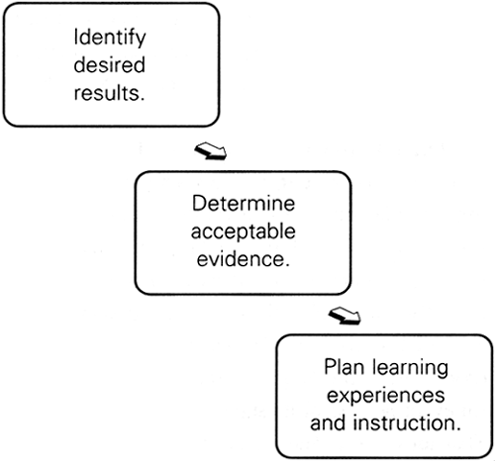Backwards Design

I brought up the topic of "backward design" last fall in one of my classes at NJIT and the students had never heard the term. One of them, not surprisingly, took his phone and did a search on Wikipedia, and we were both surprised that there was no entry. Not on Wikipedia? Then it kind of doesn't exist.
So, I put in a request for a page to be created, and recently I was notified that one has been created and we are adding and revising it.
Backward design is a method of designing educational curriculum by setting goals before choosing instructional methods and forms of assessment. That seems so logical, but we very often go the other way. "Teach to the test" would be a very obvious example.
The 3 stages are usually described as:
1. Identify the results desired (What are the big ideas and skills you want students to take away from the learning? What should the students know, understand, and be able to do?
2. Determine acceptable levels of evidence that support that the desired results have occurred (How will you assess those results? What will you accept as evidence that student understanding took place - observations, tests, presentations, projects?
3. Finally, design learning events that can make desired results happen (For example, what knowledge, skills and even tools will students need to achieve those desired results?
Backward design challenges common methods of curriculum planning, such as starting with a textbook as the content.
A common analogy used in explaining backward design is to think of it as using a "road map" where we start with the destination and then look for the best way to get there. By that analogy, traditional design would be using a road map with no destination in mind.
My NJIT students, some of whom are engineers, thought this sounded like "reverse engineering." Reverse engineering, also called back engineering, is the processes of extracting design information from anything man-made and re-producing it - a process that often involves disassembling something (a mechanical device, electronic component, computer program, or biological, chemical, or organic matter) and analyzing its components and workings in detail.
Backward design is not so hands-on, but it wasn't a bad place to start with the students. Actually, backward design is closer to the components of the ADDIE model which is commonly used in instructional design. These days instructional design is most often associated with technology and platforms for the development of learning experiences, especially online, and, unfortunately, less often associated with face-to-face teaching and pedagogy.
Historically, Ralph W. Tyler is given credit for the idea of "backward design" (though he didn't use that term in 1949). He was referring to a statement of objectives used to indicate the kinds of changes in the student to be brought about so that instructional activities can be planned and developed in a way likely to attain these objectives.
In curriculum design in the late 1980s, Jay McTighe and Grant Wiggins launched Understanding by Design (UbD)which promotes a backward approach to design that delays the planning of classroom activities until goals have been clarified and assessments designed. They promote this as a way to avoid the problems of "textbook coverage" and "activity-oriented" teaching, in which no clear priorities and purposes are apparent. UbD also promotes the use of standards and regular reviews of results (achievement data and student work) followed by targeted adjustments to curriculum and instruction.
UbD has been widely used in K-12 education and Wiggins' and McTighe's "WHERE" approach is also used for the assessment stage of the process. W stands for students knowing where they are heading, why they are heading there, what they know, where they might go wrong in the process, and what is required of them. The H stands for hooking the students on the topic of study. E stands for students exploring and experiencing ideas and being equipped with the necessary understanding to master the standard/outcome being taught. R stands for providing opportunities for students to rehearse, revise, and refine their work, and the E stands for student evaluation.
As the new Wikipedia entry notes, criticisms of this backward design approach do exist. For example, this approach ties teacher effectiveness more on the success of the students based on formulated assessments rather than ability to connect knowledge and skills to the needs and interests of students. Some critics feel that this approach shows a lack of concern with social and cultural differences within the classroom.
Trackbacks
Trackback specific URI for this entryThe author does not allow comments to this entry
Comments
No comments